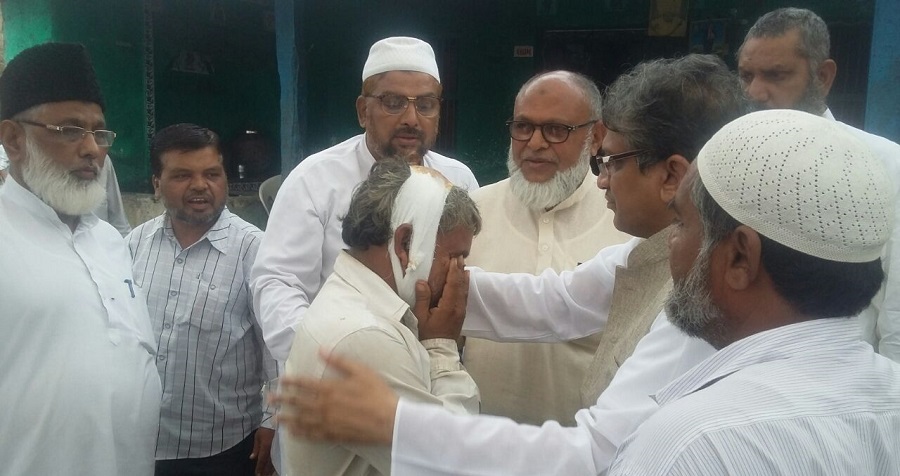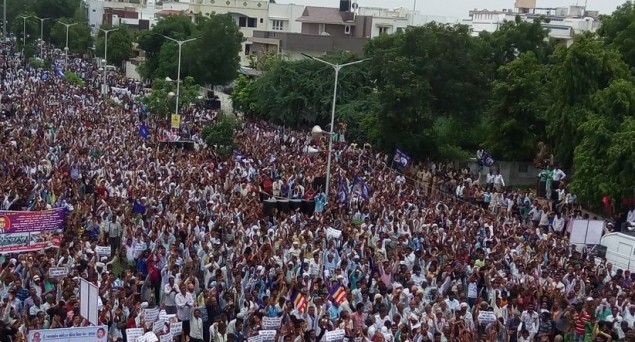The new emerging political alliance between dalits and Muslims might not only make deep changes in politics of the state but can also halt the frequent occurrence of communal violence that obstructed the growth and development of the two communities.
Fatima Tanveer,
The Dalit uprising in the state of Gujarat that began after public flogging of four dalit youths for skinning a dead cow on the outskirts of Mota Samadhiyala village in Una taluka of Gir-Somnath district on July 11, is gaining strength with every passing day. The incident though had come to the knowledge of the state government within a day of the development but the then chief minister Anandiben Patel did not take it seriously. While no case was booked against the accused involved in beating the dalits promptly, CM did not take pains to visit the victims or their families immediately. Perhaps, she believed that this latest incident of atrocity on dalits would pass off like previous incidents. The State Crime Records Bureau says that a total of 14,500 incidents of atrocities on dalits had been recorded between January 2001 and January 2016. Anandiben Patel visited the victims only after BSP supremo Mayawati raised the issue in Parliament and Delhi chief minister Arvind Kejriwal visited them.
Though dalit NGOs had been working in the state for more than two and a half decades but dalit issues had not been taken up in the way Una incident was taken up. Such a spontaneous Dalit unity and movement had never been witnessed in Gujarat before. Moreover, the current uprising has no backing of any political party or any political leader. Then what is the reason for such a spontaneous dalit uprising that attracted not only the attention of the people across the length and breadth of the country but it made international headlines as well? It is a historic moment in the history of dalits in Gujarat. It also cost the job of chief minister Anandiben Patel for overlooking the incident and delaying action against the accused calling themselves as ‘gau rakshaks’ or cow protectors.
Educated from universities and colleges, dalit youths are today working with NGOs, government departments, practicing as advocates and also working with mainstream newspapers. It is these youths, activists say, who came together to organise the community after Una incident.
Dalit activists say it is because of the emergence of a strong middle class among the dalits in the last few decades that is perhaps responsible for the dalits uniting over the Una incident. Educated from universities and colleges, dalit youths are today working with NGOs, government departments, practicing as advocates and also working with mainstream newspapers. It is these youths, activists say, who came together to organise the community after Una incident and formed Una Dalit Atyachar Ladat Samiti (Committee to fight against atrocities on dalits in Una) and it was this outfit that organised a massive Dalit ‘Mahasammelan’ (rally) in Ahmedabad on July 31, announcing a number of measures to be taken for upliftment of Dalits. It were these youths who got in touch with Muslim leaders and sought their support for their fight for justice. And Muslims also responded positively by attending the ‘mahasammelan’. In fact, the Dalit-Muslim unity after the Ahmedabad ‘mahasammelan’ has shaken the state government more than anything else because of the political impact it might have in state assembly elections due in December 2017.
In fact, the Dalit-Muslim unity after the Ahmedabad ‘mahasammelan’ has shaken the state government more than anything else because of the political impact it might have in state assembly elections due in Dec 2017.

Leaders of All India Muslim Majlise Mushawarat consoling the father of youths assaulted by cow vigilantes in Una, Gujarat.
Unlike other states, Dalits and Muslims societies are located side by side in each and every town of Gujarat and their coming together might adversely affect the electoral prospects of BJP that thrives on religious polarisation of communities. Because of Dalits’ locations adjoining the Muslim localities, hardline Hindutva groups always used them to attack the Muslims during communal violence. In fact, the attackers on Muslims during 2002 anti-Muslim riots in the state, particularly in Naroda Patiya and Gulberg Society, the worst scenes of mass massacres of Muslims, were all Dalits. But the new emerging political alliance between neo-middle class dalits representing the aspirations of the dalits across the state and Muslims might not only make deep changes in politics of the state but can also halt the frequent occurrence of communal violence that obstructed the growth and development of the two communities. And this political alliance between Dalits and Muslims might extend beyond Gujarat as well, particularly in Uttar Pradesh, where the next assembly elections are due in early 2017. What is to be noted is that it is also for the first time that BSP supremo Mayawati has openly spoken about atrocities on Muslims, while strongly condemning atrocities on Dalits. During her visit to Ahmedabad on August 4 and subsequently in press briefings in Delhi, Mayawati said that Dalits and Muslims have been the target of hardline Hindutva outfits after BJP government came to power at the Centre and its frequency and intensity was more in BJP-ruled states. In the past, Mayawati had been avoiding taking the name of Muslims or even minorities to ensure that her upper-caste supporters were not annoyed.
Unlike other states, Dalits and Muslims societies are located side by side in each and every town of Gujarat and their coming together might adversely affect the electoral prospects of BJP that thrives on religious polarisation of communities. Because of Dalits’ locations adjoining the Muslim localities, hardline Hindutva groups always used them to attack the Muslims during communal violence. In fact, the attackers on Muslims during 2002 anti-Muslim riots in the state, particularly in Naroda Patiya and Gulberg Society, the worst scenes of mass massacres of Muslims, were all Dalits. But the new emerging political alliance between neo-middle class dalits representing the aspirations of the dalits across the state and Muslims might not only make deep changes in politics of the state but can also halt the frequent occurrence of communal violence that obstructed the growth and development of the two communities.
About 20,000 Dalits led by 35-year-old former journalist and now a practicing advocate Jignesh Mevani, took a pledge at the Ahmedabad ‘mahasammelan’ that they would not do “the dirty work of the society”’ like disposal of dead cattle or skinning them and cleaning of gutters and manual scavenging. Mevani also demanded allocation of government land to landless dalits in rural areas to provide them alternate sources of livelihood, regularisation of all ‘safai’ workers in municipalities and panchayats (who are all dalits) and payment of salaries to them as per government scale and filling of more than 60,000 vacancies for scheduled castes in the state government departments. Mevani says, “So far, only the incidents of Dalit atrocity were portrayed as Dalit issues. But I believe that we need to include economic issues as well on the dalit agenda with a view to changing the conditions of dalits in the country”. He says that upliftment of dalits is not possible without land reforms in the state and finding alternate economic opportunities for dalits.
Urging Dalits to give up discrimination among various Dalit sub-castes and advocating Dalit-Muslim unity, Mevani says, “Had I had two sisters I would have married one in the Balmiki community, considered as the lowliest among the dalits, and the other in the Muslim community for a broader unity among the oppressed classes”. The son of a clerk retired from Ahmedabad Municipal Corporation, Mevani did his graduation in English literature from prestigious H K Arts College in Ahmedabad, studied journalism at Bhavan’s College and worked for a Gujarati magazine and then a Gujarati language daily for five years in Mumbai. He later on returned to Ahmedabad, did his LLB and began practicing as an advocate in the Gujarat high court.
“Had I had two sisters I would have married one in the Balmiki community, considered as the lowliest among the dalits, and the other in the Muslim community for a broader unity among the oppressed classes.”
— Jignesh Mevani, leader of Dalit uprising in Gujarat
Mevani and his colleagues are currently on a “Dalit Asmita Yatra-Azadi Kooch” (March for Dalit Pride-Starting out for Freedom) that started from Ahmedabad on August 5 and is to reach Una on August 15, the Independence Day, covering a distance of 360 kilometres. They are advising the Dalits on the way to never touch a carcass and look for alternate sources of livelihood. “Gai ki pooch tum rakho, hame hamari zameen do” (keep the tail of your cow with you, give our land to us) is a slogan that he is raising all along the yatra, telling the upper castes that they would have to dispose of the dead cattle themselves and dalits would not settle for anything less than allotment of surplus and waste government land to them.
Mevani is determined that he would not end his movement until their demand for allotment of government land is accepted by the state government. “We will even organise ‘rail roko’ (halt the trains) agitation after August 15 if government fails to meet our demand. Thousands of educated dalits are ready to even court arrest and go to prison”, says Mevani. Several dalit activists from UP and Bihar have also joined the yatra having 70 members in all. A group of Muslims under the newly formed banner – Insaf (Justice) – led by Kalim Siddiqui and his supporters are also in the yatra.
—
Disclaimer: The opinions expressed within this article are the personal opinions of the author. IndiaTomorrow.net is not responsible for the accuracy, completeness, suitability, or validity of any information on this article. All information is provided on an as-is basis. The information, facts or opinions appearing in the article may not reflect the views ofIndiaTomorrow.net and IndiaTomorrow.net does not assume any responsibility or liability for the same.





